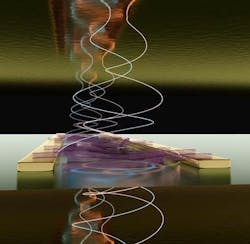Carbon nanotubes facilitate electrically pumped organic polariton laser
As described in Nature Materials, physicists and materials scientists from Heidelberg University (Heidelberg, Germany) and the University of St Andrews (St Andrews, Scotland) have demonstrated electrical generation of hybrid light-matter particles, so-called exciton-polaritons, by using field-effect transistors with semiconducting carbon nanotubes integrated in optical micro-cavities. This strong coupling in carbon nanotubes may hold the key to electrically driven organic lasers.
RELATED ARTICLE: Two groups demo electrically pumped polariton lasers
The extraordinary stability of these transistors enabled electrical pumping at unprecedented rates, which paves the way for electrically pumped lasers with solution-processed and carbon-based semiconductors. As the emission of these light sources can be tuned across a wide range of the near-infrared spectrum, this work holds particular promise for applications in telecommunications.
These results are the latest outcome of a fruitful cooperation between professor Jana Zaumseil (Heidelberg) and professor Malte C. Gather (St Andrews). Research on optoelectronic devices using carbon-based and organic materials has led to a variety of novel applications, such as organic light-emitting diodes for energy efficient, bright and high-resolution smartphones displays and TVs.
However, despite the rapid development in this area, electrically pumped lasing from organic materials remains elusive. One major challenge is to generate the high pumping rates required for lasing. Recently, so called polariton lasers have received a lot of attention as they provide a new and potentially more efficient way to generate laser-like light.
Instead of relying purely on photons as in a conventional laser, the polariton laser uses photons that are strongly coupled to the excited states of the material. This coupled nature of the polaritons can facilitate the generation of laser-like light if high enough current densities could be achieved. Previously the same team showed that it is possible to form polaritons in semiconducting carbon nanotubes at room temperature by external optical excitation. In their latest work, the researchers now found a way to generate polaritons electrically.
To achieve this, they developed a carbon nanotube-based light-emitting field-effect transistor that was embedded between two metal mirrors in close proximity acting as an optical micro-cavity. In such a device the current flow is perpendicular to the optical feedback, which allows both to be optimized independently.
Because of the extreme stability and high conductivity provided by the carbon nanotubes in this device, current densities orders of magnitude above any previously reported values were achieved. Calculations by PhD student Arko Graf, one of the first authors of the study, show that with further improvements to the device architecture, electrically pumped polariton lasing will be within realistic reach.
Professor Zaumseil explains, "Besides the potential generation of laser light, these devices can also be used to reversibly tune between strong and weak light-matter coupling, which opens a route to more fundamental investigations." Professor Gather added, "Our curiosity to understand what happens when we combine tailored nanomaterials with high-quality photonic structures is really what drives this collaboration."
SOURCE: University of St Andrews; https://www.st-andrews.ac.uk/news/
About the Author

Gail Overton
Senior Editor (2004-2020)
Gail has more than 30 years of engineering, marketing, product management, and editorial experience in the photonics and optical communications industry. Before joining the staff at Laser Focus World in 2004, she held many product management and product marketing roles in the fiber-optics industry, most notably at Hughes (El Segundo, CA), GTE Labs (Waltham, MA), Corning (Corning, NY), Photon Kinetics (Beaverton, OR), and Newport Corporation (Irvine, CA). During her marketing career, Gail published articles in WDM Solutions and Sensors magazine and traveled internationally to conduct product and sales training. Gail received her BS degree in physics, with an emphasis in optics, from San Diego State University in San Diego, CA in May 1986.
